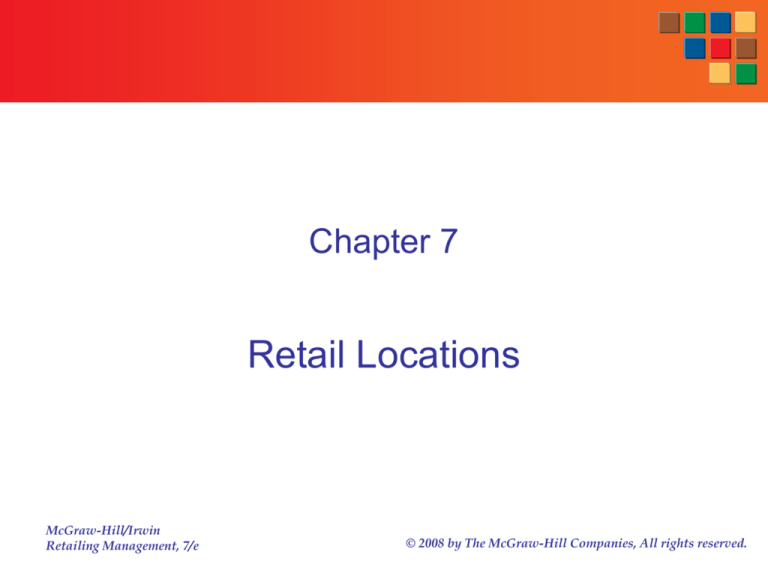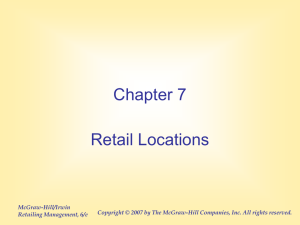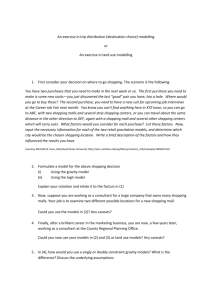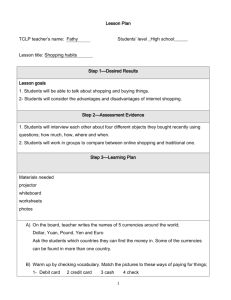
Chapter 7
Retail Locations
McGraw-Hill/Irwin
Retailing Management, 7/e
© 2008 by The McGraw-Hill Companies, All rights reserved.
Retail Strategy
Chapter 5
Financial Strategy
Chapter 6
Human Resource
Management
Chapter 9
Retail Locations
Chapter 7
Site Locations
Chapter 8
Information and
Distribution
Systems
Chapter 10
Customer
Relationship
Management
Chapter 11
7-2
Questions
■ What types of locations are available to
retailers?
■ What are the relative advantages of each
location type?
■ Why are some locations particularly well suited
to specific retail strategies?
■ Which types of locations are growing in
popularity with retailers?
7-3
Elements in Retail Mix
Location Strategy
Customer Service
Store Display
Merchandise
And Design
Assortment
Communication Mix
Pricing
7-4
What Are the
Three Most Important Things in Retailing?
Location! Location! Location!
7-5
Eddie Tan/Life File/Getty Images
Facts on Retail Space
■ Currently the U. S. has 20 square feet of retail
space in shopping centers for every person.
■ The highest country in the world
■ The second-highest country:
Sweden – 3.1 square feet per person
7-6
Why is Store Location Important for a Retailer?
■ Location is typically prime consideration
in customer’s store choice.
■ Location decisions have strategic
importance because they can help to
develop sustainable competitive
advantage.
■ Location decisions are risky: invest or
lease?
F. Schussler/PhotoLink/Getty Images
7-7
Types of Retail Locations
■ Free Standing Sites
■ City or Town Locations
Inner City
Main Street
■ Shopping Centers
Strip Shopping Centers
Shopping Malls
■ Other Location Opportunities
7-8
Selecting a particular location type
Involves evaluating a series of trade-offs between
■ The size of the trade area (geographic area
encompassing most of the customers who would
patronize a specific retail site)
■ the occupancy cost of the location
■ The pedestrian and vehicle customer traffic
■ The restrictions placed on store operations by the
property manager
■ The convenience of the location for customers
7-9
Tradeoff Between Locations
There are relative advantages
and disadvantages to consider
with each location.
Rent
Traffic
7-10
Types of Locations
7-11
Unplanned Retail Locations
■ Freestanding Sites – location for individual store
unconnected to other retailer
■ Advantages:
Convenience
High traffic and visibility
Modest occupancy cost
Separation from competition
Few restrictions
■ Disadvantages:
No foot traffic
No drawing power
The McGraw-Hill Companies, Inc./Andrew Resek, photographer
JCPenney, Sears, Walgreens are shifting to stand alone locations
7-12
Unplanned Retail Locations
Merchandise Kiosks – small temporary selling
stations located in walkways of enclosed malls,
airports, train stations or office building lobbies.
Kent Knudson/PhotoLink/Getty Images
7-13
City or Town Locations
Gentrification is bringing population back to the cities.
Advantage to Retailers:
•Affluence returned
•Young professionals
•Returned empty-nesters
•Incentives to move provided by cities
•Jobs!
•Low occupancy costs
•High pedestrian traffic
The McGraw-Hill Companies, Inc./Andrew Resek, photographer
7-14
Advantages
■
■
■
■
Draws people into areas during business hours
Hub for public transportation
Pedestrian traffic
Residents
Disadvantages
Central Business District (CBD)
■
■
■
■
High security required
Shoplifting
Parking is poor
Evenings and weekends are slow
Spike Mafford/Getty Images
7-15
Main Streets vs. CBDs
■ Occupancy costs lower
than CBDs
■ They don’t attract as
many people
■ There are not as many
stores
■ Smaller selections offered
■ Not as much
entertainment
■ Some planners restrict
store operations
7-16
Inner City
Unmet demand tops
25% in many inner city
markets
Inner city retailers achieve high sales volume,
higher margins and higher profits
Inner city customer wants branded merchandise
7-17
Shopping Centers
Shopping Center Management Controls:
•Parking
•Security
•Parking lot lighting
•Outdoor signage
•Advertising
•Special events for customers
The McGraw-Hill Companies, Inc./Andrew Resek, photographer
7-18
Types of Shopping Centers
■ Neighborhood and Community Centers (Strip
Centers)
■ Power Centers
■ Enclosed Malls
■ Lifestyle Centers
■ Fashion Specialty Centers
■ Outlet Centers
7-19
Neighborhood and Community Centers
Advantages
Convenient locations
Easy parking
Low occupancy costs
Disadvantages
Limited trade area
Lack of entertainment
No protection from weather
The McGraw-Hill Companies, Inc./Andrew Resek, photographer
Managed as a unit
Attached row of stores
Onsite parking
7-20
Shopping centers that consist primarily of
collections of big-box retail stores such as
discount stores (Target), off-price stores
(Marshall’s), warehouse clubs (Costco),
and category specialists (Lowe’s, Best Buy,
Dick’s)
■ Open air set up
■ Free-standing anchors
■ Limited small specialty stores
■ Many located near enclosed malls
■ Low occupancy costs
■ Convenient
■ Modest vehicular and pedestrian traffic
■ Convenient
■ Modest vehicular and pedestrian traffic
■ Large trade areas
PhotoLink/Getty Images
Power Centers
7-21
Shopping Malls
■ Regional shopping
malls (less than 1
million square feet)
■ Super regional malls
(more than 1 million
square feet)
The South China Mall in Dongguan, China
7-22
The Largest Shopping Malls
7-23
Advantages and Disadvantages of
Shopping Malls
Many different types of stores
Many different assortments available
Attracts many shoppers
Main Street for today’s shoppers
Never worry about the weather
Comfortable surrounding to shop
Uniform hours of operation
PhotoLink/Getty Images
Advantages:
Disadvantages:
Occupancy costs are high
Tenants may not like mall management control of operations
Competition can be intense
7-24
Challenge to Malls
■
■
■
■
■
Time pressured society makes it impractical to wander malls
Fashion apparel sold in malls experiencing limited growth
Malls are getting old and rundown – unappealing to shop
Anchor tenants are decreasing due to retail consolidation
Strategies?
Make shopping more enjoyable (e.g., sofas, children’s playing areas)
Great food destination (fast food and full-service restaurants)
Tailor make its offering to cater to changing demographics (e.g.,
repositioning older shopping centers for Hispanic markets)
Mall renovation and redevelopment
7-25
Lifestyle Centers
Photo provided by ICSC and used with permission of Aspen Grove Lifestyle Center
Attractive to specialty retailers
7-26
Stores and Restaurants at Lifestyle Centers
Williams-Sonoma
Victoria’s Secret
Restoration Hardware
Barnes & Noble/Borders
Coldwater Creek
Pottery Barn
The Gap
Banana Republic
Bed Bath & Beyond
Eddie Bauer
Panera Bread
Ann Taylor
Starbucks
Aeropostale
Dick’s Sporting Goods
Hallmark
Johnny Rockets
7-27
Lifestyle Centers
■ Usually located in affluent
residential neighborhoods
■ Includes 50K sq. ft. of upscale
chain specialty stores
■ Open-air configuration
■ Design ambience and
amenities
■ Upscale stores
■ Restaurants and often a
cinema or other entertainment
■ Small department store format
may be there
7-28
■ Upscale apparel shops
■ Tourist areas/central business
districts
■ Need not to be anchored
■ Décor is elegant
■ High occupancy costs
■ Large trade area
■ Ex. Phipps Plaza in Atlanta
The McGraw-Hill Companies, Inc./Lars A. Niki, photographer
Fashion Specialty Centers
7-29
Outlet Centers
These shopping centers contain mostly manufacturers and retail outlet stores
Courtesy of Beall’s, Inc.
7-30
Theme/Festival Centers
■ Located in places of
historic interests or for
tourists
■ Anchored by
restaurants and
entertainment facilities
7-31
Larger, Multi-format Developments:
Omnicenters
■ Combines enclosed malls, lifestyle center, and
power centers
■ Larger developments are targeted
to generate more pedestrian traffic and longer
shopping trips
To capture cross-shopping consumers
7-32
Mixed Use Developments (MXDs)
■ Combine several
different uses into one
complex, including
shopping centers, office
tours, hotels, residential
complexes, civic centers,
and convention centers.
■ Offer an all-inclusive
environment so that
consumers can work,
live, and play in a
proximal area
7-33
Other Location Opportunities
■
■
■
■
Airports
Resorts
Store within a Store
Temporary or pop-up stores
7-34
Alternative Locations
Airports
Airports: Why wait with nothing to do?
Kim Steele/Getty Images
Rents are 20% higher than malls
Sales/square ft are 3-4 times higher than malls
Best airports are ones with many connecting flights
7-35
Alternative Locations
Resorts
Captive audience
Well-to-do customer
Customers have time to shop
7-36
Royalty-Free/CORBIS
Alternative Locations
Store within a Store
■ Located within other, larger stores
■ Examples:
Grocery store with service providers (coffee bars,
banks, clinics, video outlets)
Sephora in JCPenney
7-37
Alternative Locations
Hospitals
Patients cannot leave
Gifts are available
Royalty-Free/CORBIS
7-38
Matching Location to Retail Strategy
The selection of a location type must reinforce the retailer’s
strategy
be consistent with
the shopping behavior
size of the target market
The retailer’s position in its target market
■ Department Stores Regional Mall
■ Specialty Apparel Central Business District, Regional
malls
■ Category Specialists Power Centers, Free Standing
■ Grocery Stores Strip Shopping Centers
■ Drug Stores Stand Alone
7-39
Shopping Behavior of Consumers
in Retailer’s Target Market
■ Factors affecting the location choice
Consumer Shopping Situations
• Convenience shopping
• Comparison shopping
• Specialty shopping
Density of Target Market
• Ex. Convenience stores in CBD; comparison
shopping stores next to Wal-Mart
Uniqueness of Retailing Offering
• Convenience of locations is less important
• Ex. Bass Pro Shop
7-40
Minimize the customer’s effort to get
the product or service by locating
store close to where customers are
located
The McGraw-Hill Companies, Inc./Andrew Resek, photographer
Convenience Shopping
7-41
Comparison Shopping
Customers have a
good idea of what
type of product they
want, but don’t
have a strong
preference for
brand, model or
retailer.
Competing retailers locate
Near one another
Typical for furniture,
appliances, apparel,
consumer electronics,
hand tools and
cameras.
7-42
Ryan McVay/Getty Images
Category Specialists
Offer the benefits of comparison shopping
Consumers can see almost all brands and models in one store
Destination stores
The McGraw-Hill Companies, Inc./Andrew Resek, photographer
7-43
Specialty Shopping
Customers know what they want
Designer labels
Convenient location matters less
The McGraw-Hill Companies, Inc./Andrew Resek, photographer
7-44
Virtual Shopping
7-45
Environmental Issues
“Above-ground” risks - such as asbestos-containing
materials or lead pipes used in construction.
Hazardous materials - e.g. dry cleaning chemicals,
motor oil, that have been stored in the ground.
Retailers’ Protection
Stipulate in the lease that the lessor is responsible
for removal and disposal of this material if it’s
found.
Retailer can buy insurance that specifically
protects it from these risks.
7-46
Other Legal Issues
Zoning and Building Codes
Zoning determines how a particular site can be
used.
Building codes determine the type of building,
signs, size, type of parking lot, etc. that can be used
Signs
Restrictions on the use of signs can also impact a
particular site’s desirability
Licensing Requirements
Some areas may restrict or require a license for
alcoholic beverages
7-47








